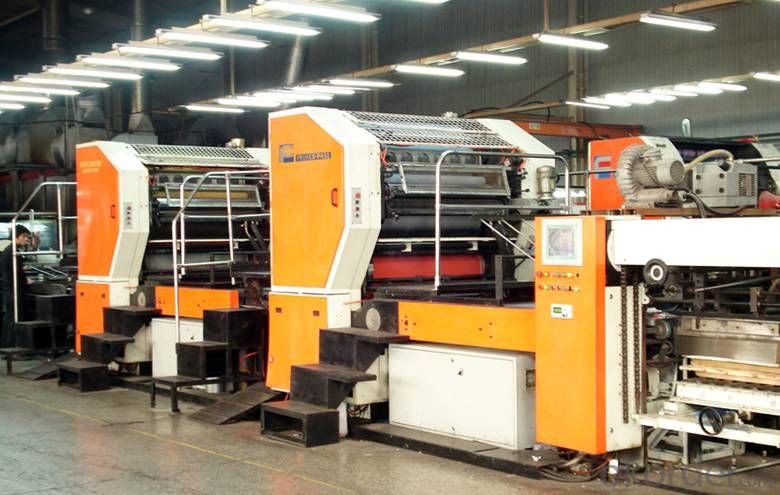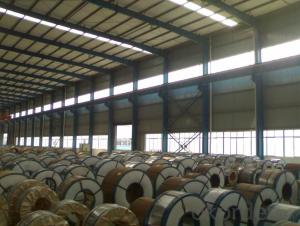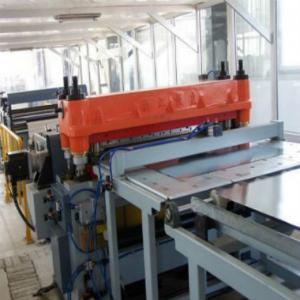Printed and Coated TFS for Metal Printing
- Loading Port:
- China main port
- Payment Terms:
- TT OR LC
- Min Order Qty:
- 25 m.t
- Supply Capability:
- 30000 m.t/month
OKorder Service Pledge
OKorder Financial Service
You Might Also Like
Printed and Coated TFS for Metal Printing
1. Product Description:
TFS are widely used for making all types of containers such as artistic cans, tea cans, painting cans, chemical package cans and metal printing etc. Its applications are not limited to containers; recently, they have also been used for making electrical machinery parts and many other products.
2. Product Features:
Fully Automatic
Beautiful Appearance
Excellent Paintability & Printability
Excellent Formability & Strength
Excellent Corrosion Resistance
Excellent Solderability & Weldability
3. Product Parameters:
Technical standard | JISG3315 and GB/T24180 - 2009 (BS EN 10202:1990) |
Steel Type | MR / SPCC |
Thickness | From 0.15mm to 0.50mm (Tolerance +/- 0.01mm) |
Width | Normally 600-1050mm (Tolerance +3/-0 mm) |
Coating | Total chromium min 30mg/m2 max 140mg/m2 |
Temper & Annealing | T1-T5, DR7-8, TS230-TH435, T49-T65(+/- 4) |
Surface Treatment | Bright & Fine Stone & Stone & Silver & Matt |
Payment terms | Letter of Credit (L/C), Telegraphic transfer (T/T) |
Price terms | CFR & CIF price term |
Delivery time | Within 60 days after received L/C or T/T down payment |
Packing | High quality shipping packing which contains thin plastic film, rust-proof paper, metal cover, metal angles and strap sand pallet. |
Minimum order Quantity(MOQ) | 25 metric tons (1X 20'' container) |
4. FAQ:
Q1: What is your delivery time?
A: Generally, the delivery time is 70 days after receive the deposit, special specification may take more time.
Q2: What is the payment term?
A: We accept both T/T and L/C. Most customers pay by T/T.
Q3: What kind of after-sevices do you provide?
A: If it is not big problem, we can solve it by emails, phone etc. Or we went to your company to slove it in person.
5. Product Pictures:


- Q: What's the difference between iron, aluminium, stainless steel, galvanized iron and tin?
- Iron is another kind of material. It is easy to be oxidized (embroidered) when it meets waterGalvanized sheet is made of iron, but zinc is plated on the surface to improve oxidation resistance. The price is cheap
- Q: What material is the tin plate, please?
- This kind of galvanized steel in a long time Chinese called "tin", some people think that the tin plate cans was made from the Guangdong province of Macao (English Macao for tinplate imports, readable) so called "tin". There are also other claims, such as Chinese used this lamp of kerosene tin plate manufacturing, shaped like a horse, so called "tin". The name "tin" not exactly, therefore, 1973 Chinese meeting has been upgraded to tin plate tin plate, the official documents will no longer use the name "tin".
- Q: What are the typical lead times for tinplate production?
- The typical lead times for tinplate production can vary depending on various factors, such as the complexity of the product, order quantity, and the production capacity of the manufacturer. However, on average, lead times for tinplate production can range from a few weeks to a couple of months. It is recommended to consult with the specific manufacturer for more accurate and up-to-date information regarding lead times.
- Q: Can tinplate be used for packaging of corrosive substances?
- No, tinplate is not suitable for packaging corrosive substances as it can react with the corrosive materials and corrode, leading to potential contamination and compromised packaging integrity.
- Q: What are the main challenges in tinplate labeling?
- The main challenges in tinplate labeling include ensuring the label adheres properly to the curved surface of the tinplate, maintaining label legibility and durability despite potential exposure to moisture, heat, or other harsh conditions, and avoiding label peeling or lifting due to the rigidity of the tinplate material. Additionally, achieving accurate and consistent label placement can be challenging due to the irregular shape and size variations of tinplate containers.
- Q: Can you tell me how to deal with the recycling of tinplate?
- The tin is magnetic, is easy to recycle scrap. Second, waste tin as scrap iron and steel melted, make steel containing a small amount of tin (less than 0.1%), to improve the performance of cast iron.
- Q: How does tinplate maintain its shape during the manufacturing process?
- Tinplate maintains its shape during the manufacturing process due to its inherent strength and durability, as well as the use of specialized machinery and techniques. The tin coating on the surface of the steel substrate provides an additional layer of protection, preventing deformation or warping. Additionally, the manufacturing process involves precise control of temperature, pressure, and other variables, ensuring that the tinplate retains its desired shape throughout the various stages of production.
- Q: How is tinplate price determined?
- The price of tinplate is determined by various factors including the cost of raw materials, market demand and supply, production and manufacturing costs, as well as any additional taxes or tariffs imposed on the product. Additionally, global economic conditions, exchange rates, and competition within the industry can also influence the pricing of tinplate.
- Q: How does tinplate impact the ease of opening and closing packaging?
- Tinplate has a positive impact on the ease of opening and closing packaging. Due to its durability and strength, tinplate provides a sturdy and reliable structure for packaging materials. This makes it easier to open and close packaging without the risk of tearing or damaging the container. Additionally, tinplate often includes features such as easy-to-use lids or pull tabs, further enhancing the convenience of accessing the contents.
- Q: How does tinplate compare to other packaging materials in terms of shelf appeal?
- Tinplate stands out among other packaging materials in terms of shelf appeal due to its unique metallic appearance, which adds a sense of premium quality and attractiveness to the product. Its high gloss finish and ability to be printed with vibrant colors and intricate designs make it visually appealing, catching the attention of consumers and stimulating their interest. Additionally, tinplate offers excellent durability and protection, ensuring that the product remains in pristine condition on the shelf, further enhancing its shelf appeal.
Send your message to us
Printed and Coated TFS for Metal Printing
- Loading Port:
- China main port
- Payment Terms:
- TT OR LC
- Min Order Qty:
- 25 m.t
- Supply Capability:
- 30000 m.t/month
OKorder Service Pledge
OKorder Financial Service
Similar products
Hot products
Hot Searches
Related keywords






















